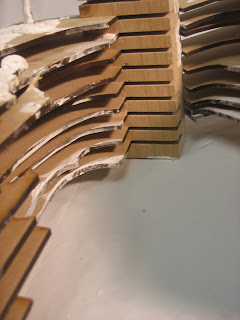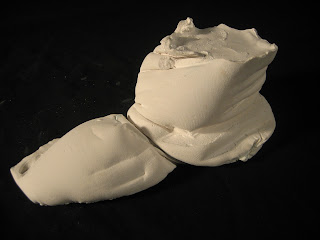Sunday, September 26, 2010
Friday, September 24, 2010
Thursday, September 23, 2010
Thursday, September 16, 2010
Sunday, September 12, 2010
Friday, September 10, 2010
Stan Allen describes field conditions as “bottom-up phenomena: defined not by overarching geometrical schemas but by intricate local connections.” What are some field condition examples that can be found in the road systems of Lubbock?
Examples of field conditions in Lubbock is the grid system that labels streets by letters and numbers, stops signs that divide intersections and order how traffic is to flow in what order and also the direction of streets: north and south, east and west.
In part 1, Allen distinguishes a geometric relationship of classical architecture from an algebraic combination of the Cordoba Mosque. How do these two architectural examples differ?
One relationship refers to a one unit being repeated to behave as a whole. Such as the Cordoba Mosque having arches and those arches were repeated over and over to create one unit. Geometric architecture using a hierarchy system in their use but continue to work as a whole unit.
What are some other examples of field conditions that can be observed around campus?
Some other field examples are the paving around campus and how each path connects to another to reach a certain area. Another example are during football games and the football stadium The stadium has set seats that are spread apart from each other at certain distances. During the games there is randomness and chaos with all the people but the stadium provides a flow for people to move through. In the cluster and randomness there is a flow that people follow because of how the stadium is designed.
How does a field condition stand to redefine the relation between figure and round?
Giam Battistanolli's example of Rome's figure ground plan is one way to see the relationship between figure ground and field conditions. It not only shows the field condition of streets and how they connects but also how the buildings around those streets interact with how the streets are planned out. With a field condition such as paving it begins to show that there is more information that must be understood than just paving.
Benedikt describes “direct esthetic experience of the real” as being moments without symbolism. Where in our environment does symbolism occur and where in our environment is symbolism absent? What is an example of this situation?
In our environment there are places such churches that symbolize religion. Example would be the Catholic church. Many churches are built to relate that symbolism. Also hospitals, government buildings, stadiums, and metropolitan areas. These places symbolize health and recovery, order, entertainment, and growth of a city. There is no symbolism in a parking lot or things like sheds and storage places. They do not symbolism anything but just as serving one purpose.
Although Benedikt’s position pulls examples from the 70‘s and 80‘s to illustrate that an architecture of reality is polar to the post-modern architecture movement, this condition continues to exist today. Where in the city would be examples of an architecture of reality and post-modern architecture?
An example of an architecture of reality would be the Administrative building. It is significant to not only students but to alumni, faculty, and staff. The building represents history of the school and it using its materials as they should be. The materials are authentic. I also believe the Jones Stadium is an architecture of reality. The stadium represents much for the school and also represents the school as a whole and where the school comes together as a whole. Post modern architecture would be found at the SUB. There are certain areas of the SUB where materials are random and done seem to be necessary.
Examples of field conditions in Lubbock is the grid system that labels streets by letters and numbers, stops signs that divide intersections and order how traffic is to flow in what order and also the direction of streets: north and south, east and west.
In part 1, Allen distinguishes a geometric relationship of classical architecture from an algebraic combination of the Cordoba Mosque. How do these two architectural examples differ?
One relationship refers to a one unit being repeated to behave as a whole. Such as the Cordoba Mosque having arches and those arches were repeated over and over to create one unit. Geometric architecture using a hierarchy system in their use but continue to work as a whole unit.
What are some other examples of field conditions that can be observed around campus?
Some other field examples are the paving around campus and how each path connects to another to reach a certain area. Another example are during football games and the football stadium The stadium has set seats that are spread apart from each other at certain distances. During the games there is randomness and chaos with all the people but the stadium provides a flow for people to move through. In the cluster and randomness there is a flow that people follow because of how the stadium is designed.
How does a field condition stand to redefine the relation between figure and round?
Giam Battistanolli's example of Rome's figure ground plan is one way to see the relationship between figure ground and field conditions. It not only shows the field condition of streets and how they connects but also how the buildings around those streets interact with how the streets are planned out. With a field condition such as paving it begins to show that there is more information that must be understood than just paving.
What is the reality Michael Benedikt writes about?
From my understanding Benedikt writes about many types of reality but the first he writes about a reality that is simple without any judgmental emotions or bias feelings. He talks about these moments happening just anywhere when you see a sunset and the simplicity of it and also the beauty. He writes about forgetting everything else and how those moments make you realize the reality you find in that moment.
Benedikt describes degrees of reality in architecture as: Architecture of Dreams, Architecture of Games, Architecture of Illusions, Architecture of Enactments and Architecture of Jokes. What are some example buildings that fall under these categories?
Architecture of Dreams: Disneyland and Disneyworld- literally a world and buildings of dreams
Architecture of Illusions- Kroger Building- Richard Haas
Architecture of Jokes- Commercial Building, Arquitectonica- the play on the windows and its angles- how the building is made of earth materials yet raised from the ground
Benedikt describes “direct esthetic experience of the real” as being moments without symbolism. Where in our environment does symbolism occur and where in our environment is symbolism absent? What is an example of this situation?
In our environment there are places such churches that symbolize religion. Example would be the Catholic church. Many churches are built to relate that symbolism. Also hospitals, government buildings, stadiums, and metropolitan areas. These places symbolize health and recovery, order, entertainment, and growth of a city. There is no symbolism in a parking lot or things like sheds and storage places. They do not symbolism anything but just as serving one purpose.
Although Benedikt’s position pulls examples from the 70‘s and 80‘s to illustrate that an architecture of reality is polar to the post-modern architecture movement, this condition continues to exist today. Where in the city would be examples of an architecture of reality and post-modern architecture?
An example of an architecture of reality would be the Administrative building. It is significant to not only students but to alumni, faculty, and staff. The building represents history of the school and it using its materials as they should be. The materials are authentic. I also believe the Jones Stadium is an architecture of reality. The stadium represents much for the school and also represents the school as a whole and where the school comes together as a whole. Post modern architecture would be found at the SUB. There are certain areas of the SUB where materials are random and done seem to be necessary.
The four components that define the “realness” of an architecture for reality are: presence, significance, materiality, and emptiness (in two categories). How do these components relate to architecture? and What are some examples of architectural elements that make up these conditions?
Presence- a building should not apologize for being there, push others aside to assert its presence, does not hide behind or disappear- some elements that make ups these conditions are literally the touch and feel of the building- the texture and materials of the building that create corners, rounded edges, and arches- a building with presence is aware of its own doors and windows and which are open or ajar- a building with presence invites people back and wants to be reentered
Significance- significance refers to the importance or meaning of the building and not for what something stands for- a building has significance when it is important to someone or the person who drew it, built it, or designed it- there are certain aspects of a building that make it significant to certain people- significance is achieved over time- the building must bring importance to human life and bring a "light" to that time- time shows if a building was built by indifferent builders or designers- a building will show its significance to humans over time and most times that building defines itself by just being a piece of architecture
materiality- this aspect seemed to be the easiest to understand- the materials used in a building reflect what type of building it is- there is a respect to where materials originate from and a building will reflect that- materiality literally reflects the realness of a building
emptiness- this component was the most difficult to understand- one way that helped to understand emptiness was to see a building like a tree- the simplicity of its nature and how a tree can be useful and beautiful- A building should not act according to accommodations of people but should act according to "structure, shelter, and the evolution of architecture"- emptiness can refer to the idea of space and the space in a building that may draw you in
Thursday, September 2, 2010
Subscribe to:
Posts (Atom)






























